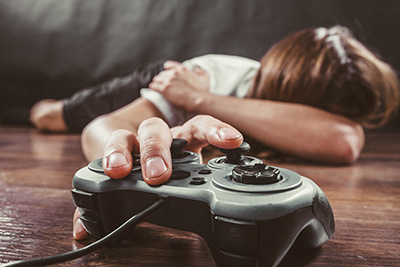
Blog Post
Part of the Hiding in Plain Sight blog series
Written by Cathy Cassata, Health & Wellness Writer
Nov. 1, 2022 / Forbes.com

With more than 215 million gamers in the United States, it’s not surprising that so many are drawn to the entertainment, competition, and sense of community gaming can provide.
One Seventeen-year-old gamer shared that he reaps such benefits as he enjoys multi-player games that require teamwork. “Working together and having fun with your friends or other players is an escape from things like high school, which is pretty stressful,” he said.
While he experiences the positive aspects of gaming, he also appreciates the value of understanding how to set appropriate limits. He took Kaiser Permanente’s Presence of Mind interactive training videos to support his understanding of mental health and addiction. The training on healthy gaming versus gaming overload hit home for him. “I learned how addictions work in the brain and how to recognize if something is addicting.”
For instance, he said there are times when he games for hours. “If I have a free day, I don’t see it as being a problem, but I learned that if I prioritize playing video games over my homework or hanging out with friends or doing things that are productive, then that’s when it becomes an issue,” he said.
When is Gaming Problematic?
Corey Arranz, PsyD, clinical psychologist at Kaiser Permanente in Georgia, pointed out the following signs of unhealthy gaming:
Because video games are designed to gain a sense of accomplishment, they target the reward center of the brain. “The reason we feel good about accomplishments is we get a release of dopamine, and that dopamine is theorized to be occurring with video game accomplishments and rewards in a similar way to gaining those in real life,” Arranz said.
For example, making a game-winning basket or defeating a character who is destroying the world in a video game feels rewarding. “And the chance to gain these accomplishments keep coming at you when playing, so it’s easy to want to keep playing for another minute, then a few minutes more, until it’s suddenly another hour,” Arranz noted.
This can be particularly hard for adolescents and teenagers whose impulse control is not as developed as adults neurologically, so the urge to keep playing is something they may have difficulty resisting.
How to Help Teens Cut Back on Gaming
Before addressing your concern with a teen’s gaming habits, Emily Gonzalez-Holland, director of Marketing Operations at Cloud9 Esports, said it’s important to recognize that video games are not inherently good or bad. “They can be both. They can be really awesome and have a detriment as well,” she said.
Rather than insisting a teen is gaming too much, “which could initially shut down any progress of having a conversation,” Gonzalez-Holland said it’s best to approach the topic with open-mindedness, compassion, and honesty. “Saying, ‘we’re concerned because we missed you in these social circles’ or ‘noticed you stopped showing up to X activity,’ is a good way to start the conversation.”
Arranz agreed. He said stick to the facts and how you feel without accusations. For example, point out the fact that their grades are suffering or that you used to see them every weekend but now only see them every two months. “That can’t be debated. But if you tell them, ‘You game too much,’ they can say something like, ‘I can stop this whenever I want,’ even though they’re having difficulty doing so,” said Arranz.
When gaming becomes problematic, consider the following:
Establish expectations rather than taking gaming away.
By telling a teen they can game as long as their grades stay up, they go to bed at a certain time, or spend time offline with friends, they will eventually replace time gaming with these activities.
“You can turn off the internet or throw away their console, but it’s more about what do they have to do to get the thing they want,” said Arranz. “Rewards work better than punishments. Rewards support behavior you want. Punishments teach a child or teenager to not engage in the activity when you’re around.”
Set an agreed upon timer.
If the teen meets expectations and is gaming, setting a time limit can help them manage their use. Once the limit is agreed upon, setting a timer 15 minutes before the end time and at the end time can keep them on track.
Explain how video games are designed.
If teens understand that video games are made with the intent of satisfying the brain’s reward system, they may acknowledge that games can become problematic. “They may possibly play less too since teenagers don’t like being controlled or manipulated,” said Arranz.
Talk with a mental health professional.
If you need further help, connect the teenager with a mental health professional who could determine if the child is living with mental health concerns, such as anxiety, loneliness, or depression. “The constant need to play games could be driven by a desire to avoid something serious,” said Gonzalez-Holland.

I have more than 15 years of experience writing about health, mental health, medical news, and inspirational people. I write with empathy and accuracy and have a knack for connecting with readers in an insightful and engaging way. I have interviewed hundreds of experts from a wide range of backgrounds, including physicians, psychologists, sociologists, researchers, and scientists, as well as everyday people about their personal health journeys. I contribute regularly to Healthline, Health.com, Verywell, and Psych Central, and have been published in Everyday Health and HuffPost. Read more of my work here, and connect with me on Twitter, Instagram, Facebook, and LinkedIn.
The “Hiding in Plain Sight” blog is a series leading to the upcoming 2022 documentary Hiding in Plain Sight: Youth Mental Illness, produced and directed by Ewers Brothers Productions, executive produced by Ken Burns, and presented by WETA, the PBS flagship station in our nation’s capital.
If you are in crisis, or experiencing thoughts of suicide, please text the Crisis Text Line (text HELLO to 741741), or call the National Suicide Prevention Lifeline at 1-800-273-TALK (8255). Both services are free and available 24 hours a day, seven days a week.
WellBeings.org is a health and wellness resource, not a crisis or suicide response website. If you are in crisis, or experiencing thoughts of suicide, please call or text the 988 Suicide & Crisis Lifeline at 988 or the LGBT National Hotline at (888) 843-4564. The service is free and available 24 hours a day, seven days a week.